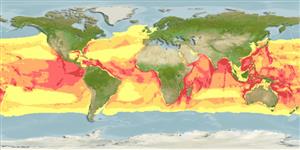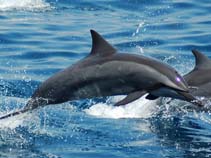Stenella longirostris (Gray, 1828)
Spinner dolphin| Native range | All suitable habitat | Point map | Year 2050 |

|
| This map was computer-generated and has not yet been reviewed. |
| Stenella longirostris AquaMaps Data sources: GBIF OBIS |
Classification / Names Common names | Synonyms | CoL | ITIS | WoRMS
Mammalia | Cetartiodactyla | Delphinidae
Environment: milieu / climate zone / depth range / distribution range Ecology
Pelagic; oceanodromous (Ref. 75906); depth range 0 - 4330 m (Ref. 116169). Tropical; 90°N - 90°S, 180°W - 180°E
Distribution Countries | FAO areas | Ecosystems | Occurrences | Introductions
Atlantic Ocean and Indo-Pacific: Stenella longirostris longirostris: Around oceanic islands in the tropical Atlantic, Indian, Western and Central Pacific east to about 145°W. Tropical, subtropical.
Length at first maturity / Size / Weight / Age
Maturity: Lm 164.1, range 152 - 182 cm Max length : 240 cm TL male/unsexed; (Ref. 1394); 200 cm TL (female); max. published weight: 77.0 kg (Ref. 1394)
Short description Morphology
Spinner dolphins have various forms depending on their geographical locations. Commonly, these are small and slender animals that have a relatively long slender beak. It has a tripartite coloration which consists of a dark grey dorsal cape, lighter grey lateral field and a white or very light ventral field. A dark band runs from the eye to the flipper, bordered above by a thin line. It has a clearly discernible contrast of cape with the lateral field and a smooth curve on the ventral margin of cape over the eye. The ventral white field extends dorsal variably nearly to level of eye; margin speckled; genital and axillary areas confluent. It also has a high to medium contrast between flipper band and gular region wherein variable spots are visible. Its flippers are dark or speckled. In adult males the dorsal fin is falcate to triangular and has a small to medium protuberant ventral keel.
Dolphins are directly caught for use as shark-bait in Sta. Ana and Aparri, Philippines (Ref. 77119).
Life cycle and mating behavior Maturity | Reproduction | Spawning | Eggs | Fecundity | Larvae
Sexual maturity attained between 4 to 7 years (females, 165-170 cm) and 7 to 10 years (males, 160-180 cm). Promiscuous, with observable courtship display. Gestation period averages 10 months, produces only one calf. Born at 3-year intervals, calves are nursed for at least a year and weaned between 1 to 3 years (Ref. 80521).
Main reference
References | Coordinator | Collaborators
Tan, J.M.L. 1995. (Ref. 936)
IUCN Red List Status (Ref. 130435: Version 2024-1)
Least Concern (LC) ; Date assessed: 20 February 2018
CITES status (Ref. 108899)
Appendix II: International trade monitored
CMS (Ref. 116361)
Appendix II: Migratory species conserved through agreements
Threat to humans
Human uses
Fisheries: commercial
FAO - Fisheries: landings, species profile | FishSource | Sea Around Us
Tools
More information
Trophic Ecology
Ecology
Population dynamics
Life cycle
Distribution
Human Related
Aquaculture profile
Stamps, Coins Misc.
Stamps, Coins Misc.
Outreach
References
Internet sources
BHL | BOLD Systems | CISTI | DiscoverLife | FAO(Fisheries: species profile; publication : search) | Fishipedia | GenBank (genome, nucleotide) | GloBI | Gomexsi | Google Books | Google Scholar | Google | PubMed | Tree of Life | Wikipedia (Go, Search) | Zoological Record
Estimates based on models
Preferred temperature
(Ref. 115969): 2.6 - 14.4, mean 4.8 (based on 3285 cells).
Resilience
(Ref. 69278):
High, minimum population doubling time less than 15 months (K=0.41-0.54; tm=5).
Price category
(Ref. 80766):
Unknown.



